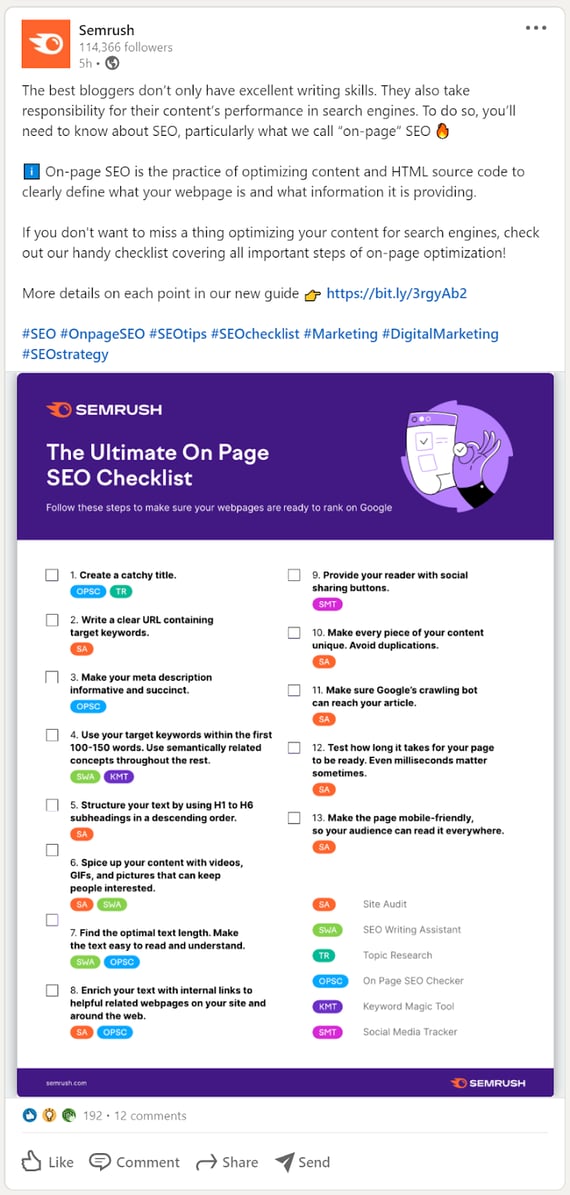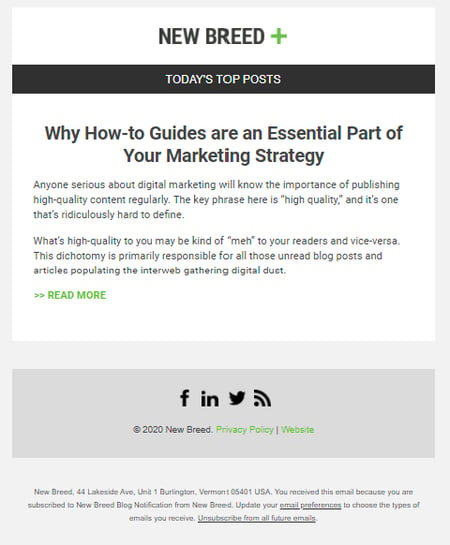When to retire content on your B2B SaaS website
Knowing when to retire content vs. producing new content can be a challenge. If you’re on the fence, use these tips to guide your website content...

LinkedIn has become a content marketer’s playground. From short 3-sentence posts to sliding image galleries and network surveys, users are finding more and more ways to get creative with content creation.
However, as a content marketer, it can be difficult to wait for the results you’re looking for, especially in a sea of digital information. Whether it’s a set amount of contacts, page views, CTA clicks, or even asset downloads, you want the best results.
But if there’s one thing content marketing professionals should know, it’s that content marketing doesn’t end when you hit “publish” on your post.
If anything, your work is just beginning.
Boost awareness, kickstart organic growth, and get content marketing support for every stage of your marketing funnel. Leverage our team of specialists and a custom GTM strategy to start seeing impactful results.
Content can fail to deliver its return on investment, especially if your intended audience can’t find it. To prevent this, you should define the following as you set the foundation of your content:
Without the above details ironed out, your content might not serve an audience, address a pain point, or align with your strategic initiatives. Rather, it’ll remain un-clicked, un-read and unvalued. Which begs the question -- why did you publish it in the first place?
While optimizing your content with on- and off-page SEO best practices allows your audience to find your content, this process takes time, patience, monitoring, and research. Search engine optimization is at the foundation of providing the right value to ‘hand-raisers,’ but it’s also important to reach people who aren’t actively searching for your content (but can benefit from it nonetheless).
So how can you ensure that your content is reaching your intended audience, and how can you expand your reach?
While B2C content marketing often relies on the use of Snapchat, Instagram, YouTube, and other social media platforms, many B2B marketers rely on a narrow set of platforms to promote content.
When using Facebook and LinkedIn as your primary social media platforms, you gain the ability to reach and target professionals from around the world who match your ideal customer profile. By doing this, your content will reach the right audience(s) with content they can learn from and apply to their own lives.
When you publish content for a specific audience, industry or field, follow these six promotional strategies to deliver value for your readers and ROI for your company.
From determining the right hashtags to accompany your posts to understanding when (and where) your content is most likely to reach your intended audience’s radar, there’s a lot you can do to leverage algorithms and information organization to your advantage.
When I publish a new content marketing blog that I want to drive traffic to, I begin by sharing the article from my personal LinkedIn profile with hashtags such as #contentmarketing, #b2bsaas, and #copywriting. When you’re getting ready to syndicate content online, make sure you’re researching and planning which LinkedIn hashtags you’ll leverage for your post (I recommend a maximum of three).
Endorsing your fellow content creators is an awesome way to build relationships, network within your industry, and support fellow writers. Whenever you publish new content online, ask your coworkers and peers to share the article online. When you do this, don’t just copy and paste the blog’s first paragraph -- identify the value proposition in a unique way and give readers a taste of what they could gain.
Whenever your peers publish content on your company blog or third-party platform, give their article a share and comment! Doing this will steadily improve your network, expand your content’s reach, and ultimately allow you to access the intended audience your content will provide the most value for.
Whenever you publish a new piece of content, it’s a good idea to share the URL within LinkedIn groups. If you’re not familiar with LinkedIn groups, they’re simply online communities for professionals of the same industry (or with similar interests) to share their insight, ask questions, and provide resources that others within their field or industry might benefit from.
For professionals in content marketing, I recommend joining the following LinkedIn groups:
For professionals creating content in an industry outside of content marketing, don’t worry - there are plenty of niche online groups that encompass a wide variety of interests and industries -- from land development to public sector, higher education and more.
When I post in these communities, I typically start by introducing myself as a content writer and providing an overview of the main “value proposition” my content delivers to intended readers. Sometimes, I’ll ask for feedback, comments, or suggestions to improve on my content in the future. I like to do this to engage with readers that might otherwise just open the link and then keep scrolling on LinkedIn, and it can encourage others to get involved, too :)
There are many different techniques to syndicate your content, and I often turn to Medium first. For those of you unfamiliar with Medium, it’s a blogging platform with millions of new and syndicated pieces of content. There are communities of content categories on Medium, from The Economist to UX Collective, and it’s similar to Reddit when browsing and reading through content.
When you syndicate content via Medium, simply copy and paste as much of your blog content into the editor as you want to share. Then, add a link to the original post on these platforms to increase your domain authority through backlinks.
When you’re uploading content through a syndication platform, make sure you optimize by adding tags, a title, and a description, as these will help readers find relevant content. And as always, make sure to research which tags are attracting the largest audiences.
Break up your content into small, digestible chunks and share them across LinkedIn (or other social media platforms) to engage your audience with your most recent content.
This technique is super easy and requires very little extra work -- simply pull statistics, findings, quotes and other valuable information from your original content & make these smaller posts to relate back to your content. You can atomize your content with graphics, polls, text posts, and even short videos.
Check out this awesome example from SEMrush, using an infographic checklist to catch attention and drive readers to their blog:

By breaking up your content into sub-topics and smaller chunks, you can personalize your message toward audiences according to their interests, giving you a better chance of attracting traffic. If you know which audience members you’re targeting, including their fears, dreams and pain points, you can pull out content that will be most relevant to them in hopes of getting a page visit to your original content!
Proven time and time again to be one of the most cost-effective marketing tools, use email marketing to create awareness and drive traffic and to your blog or content. You can do this by setting up RSS blog feed notifications through your WordPress or Hubspot website, or you can send out weekly/monthly newsletters to your current contacts..
Emails don’t have to be complicated either -- as long as you’re providing the right content to the right people, people won’t unsubscribe. Here’s a great example by New Breed:

Using email is easy to test and monitor across subject lines, body content, and CTA, and it delivers a high ROI. This is something to continuously improve, so make sure you’re monitoring email performance metrics in a way that works for you.
Content marketing isn’t as straight-forward as it seems. Promoting your content after publication is essential to expand your reach to your audience, while careful alignment with keyword research and market patterns will provide the value they’re seeking. Put it all together, and you’re delivering exactly what your intended audience wants, and you’re making it easy for them to find.
Without a solid foundation of your keyword research, intended audience, funnel stage, and information design, your content won’t provide much value to anyone. LinkedIn has become a content marketer’s favorite tool in the B2B community, and there are valuable learning lessons for everyone - from interpersonal communication to tactical knowledge, it’s a great place to network and promote your content.
So when you’re posting and sharing content across LinkedIn and other platforms, don’t forget to be human, and don’t try to hide behind a ‘professional façade.’ Just be your most authentic self!
Knowing when to retire content vs. producing new content can be a challenge. If you’re on the fence, use these tips to guide your website content...
Discover how to build a results-driven B2B SaaS content marketing strategy for 2025. Learn actionable strategies to create content that converts.
Many B2B SaaS businesses are not using their release notes to their full potential. Learn how to craft engaging content for your next update using...
Be the first to know about new B2B SaaS Marketing insights to build or refine your marketing function with the tools and knowledge of today’s industry.